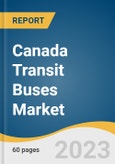Smart transport system enables efficient traffic management by combining data analytics and wireless connectivity technologies to make public transportation more efficient and secure. To address the problem of rising environmental pollution due to widespread travel and transportation, the Canadian government is offering funding & incentives to replace fossil fuel-based buses with electric buses, which is expected to boost the Canadian transit buses market growth in the coming years.
Growing concerns regarding the substantial rise in greenhouse gas and carbon emissions have encouraged various Canadian government officials to make serious changes in their policies regarding electric vehicles. For instance, in April 2023, Saskatoon Transit, the public transport arm of the City of Saskatoon, Saskatchewan, Canada, signed a contract with Nova Bus, a subsidiary of AB Volvo, to supply two Nova LFSe+ electric buses. The long-range electric buses have a range of more than 300 km on a single charge and are expected to save USD 302.8 in fuel costs.
The increasing number of collaborations between private bus operators and OEMs has been one of the crucial factors contributing to the Canadian transit bus market growth. These collaborations have fostered several aspects of the industry, including bus features, easy accessibility of the buses for passengers, and associated infrastructural growth. For instance, in January 2023, Winnipeg Transit, a public transportation company in Manitoba, Canada, collaborated with New Flyer, a bus manufacturer, to deploy eight units of battery-powered and fuel-cell buses annually until 2027. Through this partnership, Winnipeg Transit aims to achieve its target of a complete transition to an electric fleet by 2040. The proposal also includes developing a transit workforce training plan to generate well-paying union jobs, address climate change, and prioritize financing for communities with the most severe air quality issues.
Industry participants prioritize new product launches, strategic partnerships, and collaborations as part of their growth strategy to improve their product portfolio and expand their market reach across different regions. For instance, in May 2023, Daimler AG introduced the eCitaro fuel cell along with the launch of the first serial electric bus with fuel cells as a range extender. The vehicle boasts a range of 250 km with a carrying capacity of 128 passengers.
Canada Transit Buses Market Report Highlights
- Several provinces of Canada, such as Ontario, Quebec, Manitoba, and Saskatoon plan to convert their public transport fleets to electric bus fleets by 2035. As a result, with supportive government initiatives, the market for transit buses in Canada is expected to offer numerous growth opportunities to marketers over the forecast period
- The electric segment is projected to register the highest CAGR over the forecast period. The growth of this segment is attributed to the increasing preference for electric transit buses for tourism, pick-and-drop, and leisure activities, driving the growth of the Canadian transit bus market
- Prominent industry participants such as AB Volvo, NFI Group, Daimler AG, Proterra Inc., and Iveco S.p. A. are poised to secure major orders for electric buses in the coming years. Moreover, the OEMs are also focusing on training and hiring skilled laborers that fit effectively in the evolving electric ecosystem for the bus market
Table of Contents
Companies Mentioned
- AB Volvo
- Anhui Ankai Automobile Co., Ltd.
- Blue Bird Corporation
- Daimler AG (Mercedes-Benz Group AG)
- Iveco S.p.A
- Navistar, Inc. (Traton SE)
- BYD Company Limited
- Proterra Inc.
- NFI Group
- FirstGroup plc
- Group Keolis SAS
- Mobico Group
Table Information
| Report Attribute | Details |
|---|---|
| No. of Pages | 60 |
| Published | September 2023 |
| Forecast Period | 2022 - 2030 |
| Estimated Market Value ( USD | $ 126.5 Million |
| Forecasted Market Value ( USD | $ 307.2 Million |
| Compound Annual Growth Rate | 12.2% |
| Regions Covered | Canada |
| No. of Companies Mentioned | 12 |









